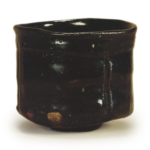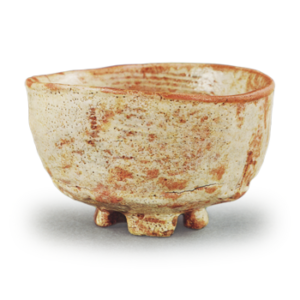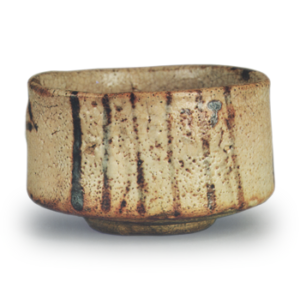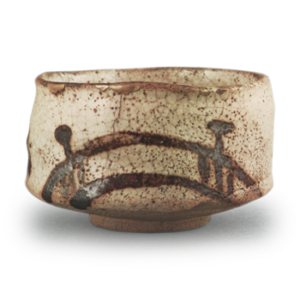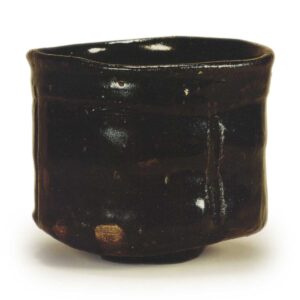
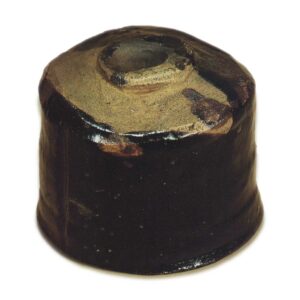
Height: 10.0cm
Diameter: 10.3-12.0cm
Foot diameter: 4.5-5.0cm
Height: 0.7cm
The lid is marked “Seto Rikyu”, but this tea bowl is considered to be a Setoguro teacup in terms of its production process.
Whether it is the Rikyu Seto “Banzai” teacup from the Nagoya Hakushokan or this cylindrical teacup, the “Rikyu Seto” or “Seto Rikyu” teacups seem to differ somewhat from ordinary Setoguro in terms of their production style.
They are deeper than ordinary Setoguro, and the foot ring is also slightly different. Many of the ordinary Setoguro are thought to have been made in Okaya during the Tensho and Bunroku periods, but the tea bowls known as “Rikyu Seto” are slightly later in terms of their production, and are thought to have been made in Kujiri during the Keicho period. Many pieces of Setoguro with the same characteristics as this have been discovered at the site of the old kiln at the Hisajiri residence. However, the origin of the name “Rikyu Seto” or “Setorikyu” is not clear.
The body is almost the color of an eggshell. The clay is a sandy, rough-textured clay, and the black-amber glaze is thickly applied both inside and out, but the foot and half of the foot rim are unglazed.
The shape is a deep, almost cylindrical bowl with a slightly flared mouth, and the body has several thick wheel marks. The waist is tight, and the foot is carved in the Japanese style, but it is low and small. The back of the foot has been scraped with a wooden spatula and then shaped by hand, so the foot is extremely thin.
There are three thick vertical lines on the body, but I have not seen many examples of this in ordinary Setoguro, and there are some things in common with Oribe in the mouth area, body shape, vertical lines, and footwork. Like Setoguro, it was pulled out of the kiln while it was still bright red when it was fired, and you can see what looks like it was pulled out of the kiln with iron scissors in the middle of the vertical line on the left side of the foot ring photo shown here.
The inside of the box is made of paulownia wood, and there is a label on the back of the lid written in the old style of calligraphy by Ryoban, and the label on the front of the lid states that it was written by Sakuma Funsai (Masakatsu).
It is said to have been passed down in the Fukiwara family of Bishu, but it is a tea bowl that was not generally known about in the past.

